| 1 | A catfish-eating snake |
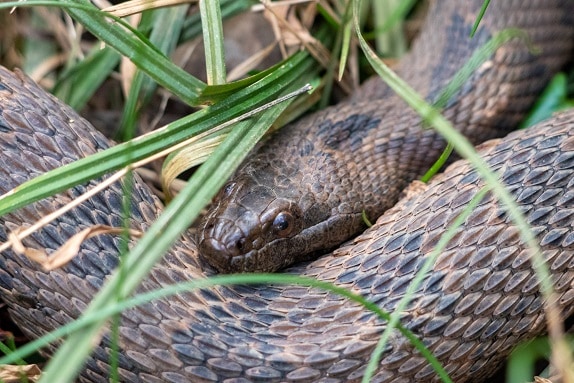
The brown watersnake is an abundant species of the southeastern USA, found mostly in streams, lakes and reservoirs. This snake has several watery neighbours, but its unique feature is its diet. Most semi-aquatic snakes rely on watery creatures like frogs and fish, but brown watersnakes get the majority of their calories from one family: catfish.
From 1991 to 1988, a study followed brown watersnakes along the Savannah river of Georgia. 257 had food in their stomach, and of the 168 species identifiable, all were fish and 63% were catfish. Once younglings grew past 60cm, they switched to catfish almost exclusively.
Brown watersnakes are extremely fussy in captivity, rejecting all offerings except fish. One specific species is the common channel catfish (Ictalurus punctatus), which measures 31-48cm next to the brown watersnake’s 50-174cm.
Lab experiments have placed amphibian and fish scents in front of brown watersnakes, and they always preferred the fish scents. The love of catfish seems to be in their genetics. The only other catfish specialist in serpents is the hook-nosed sea snake. Its northern watersnake relative also eats catfish, but not as exclusively.
| 2 | Punctured by spines |
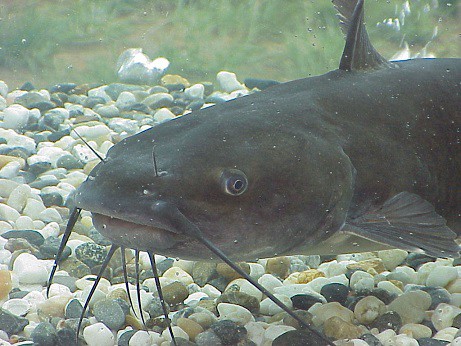
Eating catfish is no walk in the park either. Catfish are naturally spiny, the classic characteristic of the family, and brown watersnakes are often spotted with those spines sticking out of their bodies.
They’ve evolved a few tactics, as they normally wait for the catfish’s spines to relax before swallowing. They suck them down headfirst and slowly swallow more and more, until pausing at the dorsal (back) fins, where they rotate the catfish’s body 90 degrees for a safer, non-spiny angle. But this method isn’t infallible, and some brown watersnakes have died from their last fatal meal, with their bodies punctured beyond repair.
Equally though, they have a strange ability to survive those punctures. One female spotted on August 27th 1992 was covered with spines, yet 5 years later, she was not only alive, but had grown from 59.4cm to 101cm. Some brown watersnakes are spotted with old historic spines lodged in their bodies, like an old 19th century harpoon stuck in a whale.
| 3 | Source of a classic legend |
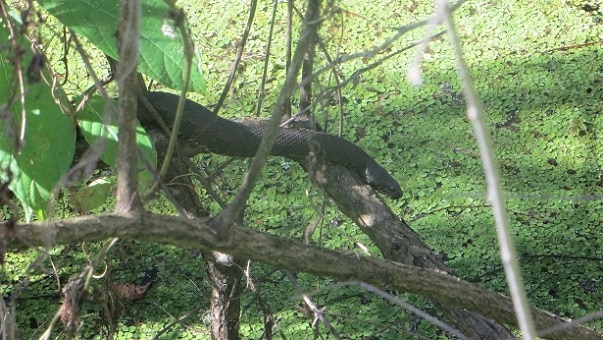
Rumours persist that the highly venomous cottonmouth will leap off tree branches and land on fishermen’s boats sailing underneath, in order to massacre everyone on board. In reality, cottonmouths are too clumsy to rest on thin branches, and it’s brown watersnakes which spooked all those fishermen over the years.
Brown watersnakes are excellent tree climbers and often reach 20 feet above ground. There, they bask in the sun for hours without moving, resting on branches directly overlooking the river shore. Males and females even mate on those branches, having a fine sense of balance.
The confusion originates with their predator-dodging strategies: the brown watersnake’s default when spooked is to detach from a branch rather than grip it harder. This likely evolved to combat birds like red-shouldered hawks, rather than alligators and snapping turtles in the watery world below. Unfortunately, fearful anglers often bludgeon the snake to death, or blast them with a shotgun once they drop down (usually capsizing their own boat…).
| 4 | ID: the blotches never touch |
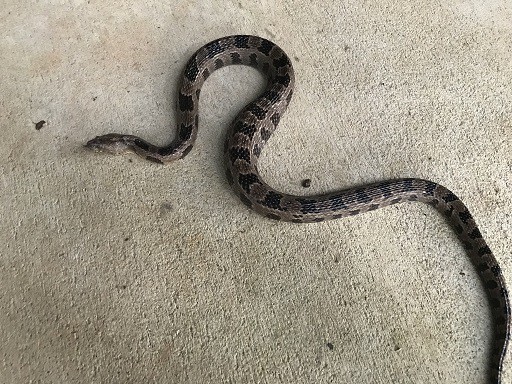
Brown watersnakes (Nerodia taxispilota) are constantly confused with cottonmouths, to the point that they’re given the interchangeable name of moccasin by locals. The basic colour scheme of muddy brown against muddier brown is similar, but an obvious difference is the pupils, which are vertical in cottonmouths and round in brown watersnakes. Cottonmouths also have larger, bulkier heads, and the darker patterns on their sides meet in the middle, whereas with brown watersnakes, the blotchy patterns never touch.
Its fellow watersnakes are another ID arena. In Virginia, for example, there are three species. The plainbelly watersnake (Nerodia erythrogaster) could never be confused, as its scales are a grey-blue, which contrasts sharply with a pale yellow stomach.
The northern watersnake (Nerodia sipedon) is closer in its main scales, but has white, yellow and red stripes which the others completely lack. When they age they become a more consistent (and easily confused) brown, but like the cottonmouth, the colourful patterns on their sides always meet on their back. Brown watersnakes are the only species where each blotch stands independent.
| 5 | Nicknames and myths |
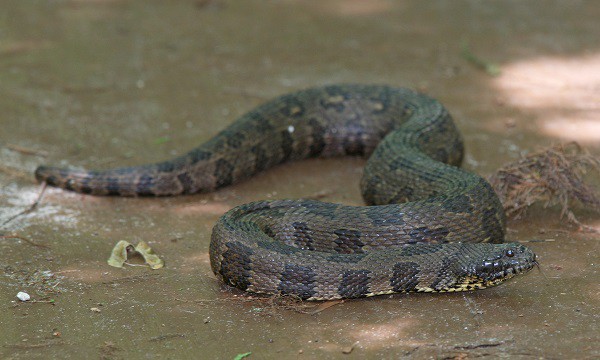
The brown watersnake’s many names include water rattle, false moccasin, great water snake, pied water snake and aspic. Some have funny origins, rooted deep in centuries old folklore which is impossible to disprove. For example, “water pilot” comes from a belief that brown watersnakes guide other snakes to safety, including cottonmouths, gliding across a stream with their allies close behind.
“Water rattler” is equally crazy. Supposedly, brown watersnakes were originally a rattlesnake, but accidentally lost their rattle after hanging around in water for too long (probably saying “damn it” afterwards).
We probably don’t need to state this, but brown watersnakes almost certainly don’t form grand alliances with other snakes. In fact, cottonmouths are known to hunt and eat them.
In human encounters, brown watersnakes are barely aggressive at all, usually playing dead when encountered on the shores of a stream. Occasionally, they’ll thrash and bite violently with their non-venomous teeth, but this sudden burst of mischief normally extinguishes within one minute. Afterwards they’ll become docile, relaxing as you hold them. Sometimes they take the play dead act too far, and stop breathing.
| 6 | Less common in swamps |
Compared to other semi-aquatic snakes, brown watersnakes stick to their lake or stream much more closely. They’re rarely found 500 metres away in a rainstorm like the more adventurous mud snake. The furthest they’ll stray is a shoreside log, to bask in the warm sunlight. Compared to the swamp-dwelling mud snake, they prefer larger bodies of water like reservoirs, lakes and streams.
Brown watersnakes always stick to permanent bodies of water. They never appear in temporary streams, dried out river beds that flow anew after heavy rainfall, because those places are inaccessible for their dietary staple of fish. Cottonmouths are different; they’re more reliant on frogs, which can travel by land and turn those seasonal streams into their strongholds. Places you’ll find all three snakes at once include oxbow lakes, beaver ponds, and cypress swamps (where hungry alligators are also a character).
Brown watersnakes reside in the following states: Virginia, North Carolina, South Carolina, Georgia, Florida, Missouri, Alabama, Mississippi, and Louisiana.
| 7 | Engages in lakeside orgies (2020) |
Brown watersnakes rarely make the news, but in 2020, officials at the wildlife-heavy Lake Hollingsworth in Florida received a spate of concerned call from locals. They claimed to have seen an army of cottonmouths gathering on the lake’s shores, and were starting to feel scared. The city of Lakeland closed the park in response, but investigations revealed that they were actually harmless brown watersnakes.
They weren’t gathering in a plot to take back what was rightfully there’s, but mating. It was nothing less than a fully fledged snake orgy, as the limbs of trees along the shoreline were covered with curled up serpents. The city kept the park shut in the interests of wildlife, strapping up tape with a warning.
Something noticeable in the TV reports was how miniscule the males were compared to the females. They looked like normal snakes breeding with mythical giantesses to create future half-giants, and the truth is that female brown watersnakes are particularly large, compared to cottonmouths where males are slightly bigger.
| 8 | Constantly losing its tail |
No sea snake on Earth is able to breathe underwater, and no snake has gills like a fish, but brown watersnakes are able to stay underwater for 30 minutes at a time. Several adaptions acquired over millions of years make this possible, including enlarged lungs and red blood cells with a higher affinity for haemoglobin.
Brown watersnakes are resilient and flexible; they can dive again and again without recovering from the oxygen deficit of the previous dive. Their first response when seeing a predator is to dive deeper into the depths and find a submerged shelter like a log.
Their plans don’t always succeed though. A 1982 survey in the Appomattox River of Virginia found that 21.4% of males and 22.2% of females had the end of their tails missing. The blame was pointed at snapping turtles, a solitary, notoriously vicious turtle which also targets cottonmouths. It’s believed that brown watersnakes thrash excessively when caught in a turtle’s iron jaws, causing the tail to snap off.
| 9 | Brown, brown and more brown |
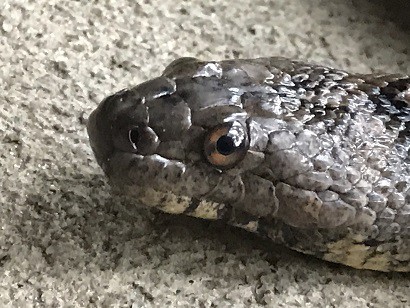
One interesting fact about brown watersnakes is that their patterns shift depending on wetness. As they bask in sunlight, they become a uniform muddy brown, but when they leap into their lakes again, the blotchy patterns tend to reemerge.
Their eyes are another distinctive sign. They’re not only small and beady, but unusually high on the head, to allow unblocked vision when gliding through the water. They also have unusually brown eyes, with the muddy brown of the scales extending unbroken through their irises. The belly, meanwhile, keeps the brown, but adds in dozens of creamy yellow patches, in complex patterns similar to a checkerboard smashed with a hammer.
One reason why brown watersnakes are confused with cottonmouths is that they’re another heavy bodied snake, thick and muscular like they’d be able to strangle you if they actually cared one iota about the human race (which they don’t). Their length ranges from 75cm to 150cm, with the all time-record being 177.8cm. Hatchlings are born alive, with each mother creating 14-58 newborns in August.
| 10 | Three hunting strategies |
Brown watersnakes take dips and dabs from all over the snake world when it comes to hunting. Their first method is a stealthy ambush borrowed straight from an emerald tree boa. Brown watersnakes will anchor their tails around a low-hanging branch or maybe a thin log, and extend their upper body downwards into a river, searching for underwater prey. They’ll move at imperceptible speeds, and as a fish swims past unknowingly, they’ll lunge and grab them with their jaws, with their tail still anchored.
The second method is active foraging, and this is closer to an Australian coral reef snake. The brown watersnake will slowly prowl the riverbed, searching patiently for nooks and crannies, hoping to flush out the catfish lurking within.
A rarer strategy is simply chasing the fleeing catfish with their mouth wide open, ditching all subtlety. Once a catfish is seized, brown watersnakes will always move to shallower waters or the shore to begin the tricky process of eating them.
